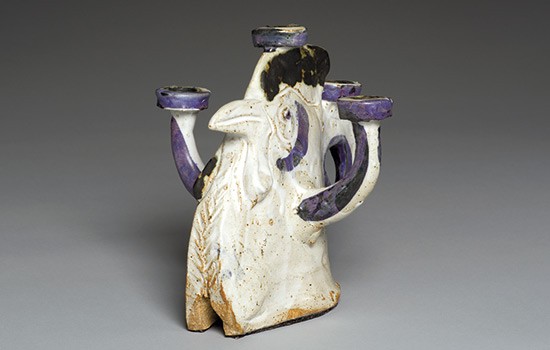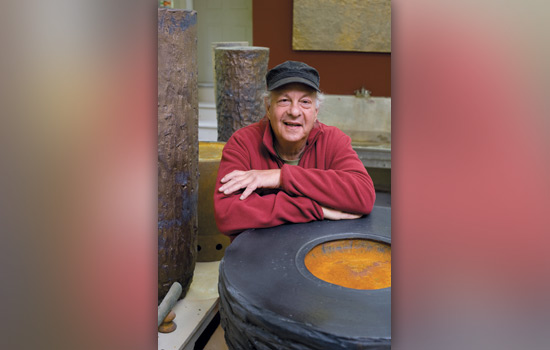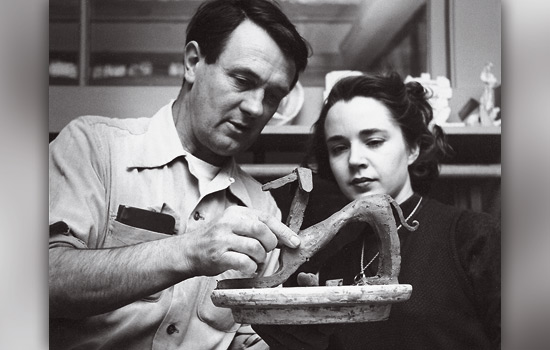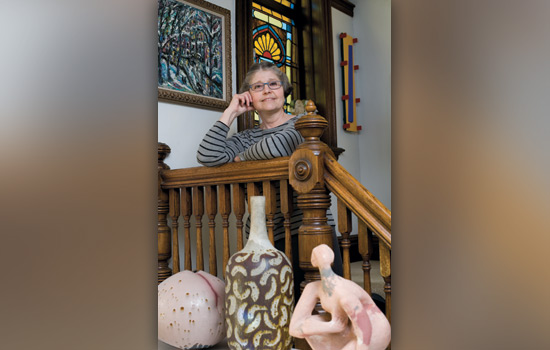Artists cut from the same mold
School for American Crafts alumni remember Frans Wildenhain’s ceramic legacy
A. Sue Weisler
If students crossed the line with Frans Wildenhain, he’d let them know it. The master potter had plenty of fire layered with a hard glaze of criticism that made him a highly recognizable figure at the School for American Craftsmen.
He was larger than life to his students, recalls Richard Hirsch ’71 (MFA), who describes the German-born, Bauhaus-trained ceramist and educator as “tall, big-boned, with a booming voice you could hear from Bevier Gallery halfway to New Jersey.”
“And he wasn’t shy either,” says the professor at what is now the School for American Crafts, who was in Wildenhain’s last class of students in 1969. “He was a large man in every respect. He had hands the size of suitcases, very little patience, a short fuse and an opinion on everything. He wasn’t what you call politically correct. When he walked into a room, you felt his presence both physically and charismatically.”
From 1950 to 1970, Wildenhain’s early 20th century ceramic initiatives helped illuminate the history of art programs at RIT, and his legacy continues today through the work of his students.
Hirsch, who grew up in Manhattan, is a renowned ceramist and among the leaders in the contemporary arts movement. He has taught for 41 years, 25 at RIT, and basically inherited the same “hot seat” as Wildenhain did more than a half-century earlier.
“Frans didn’t care about color or glazes; he said ceramics had three important ingredients: Form, form and form,” Hirsch recalls.
“As a student I started to experiment with Raku, a Japanese medium he couldn’t understand and didn’t like. He would say in his thick German-American accent, ‘Reechaud, what vill you do? Naya! Raku—it is always cracked, which means it’s always broken.’
“But I pursued it anyway, and he learned to respect my work—although he would rarely give out compliments.”
Equally challenged by Wildenhain was Rochester artist Tarrant Hookham Clements ’68 (MFA), who grew up in Chicago, attended Grinnell College in Iowa and later studied at Pond Farm Pottery in Guerneville, Calif., about 70 miles north of San Francisco.
“I went to study with Marguerite, Frans’ first wife (Wildenhain was married three times, the last to Elisabeth “Lili”) who was nine years older and a production potter,” Clements explains. “She and Frans met at the Bauhaus in Weimer, Germany, before the shop moved to Holland. Marguerite was a French citizen and also Jewish, so when the war started and the Nazis took over Holland, the mayor came to her and said he couldn’t protect her anymore. She left that night and came to America and ended up in California.”
Marguerite felt so strongly about Wildenhain’s artistic excellence that she convinced Clements to apply to RIT for graduate studies. RIT’s SAC program, which Wildenhain helped found in 1950, is modeled after the Bauhaus method with two instructors.
“Frans had a wonderful teaching partner in Hobart Cowles, who was his complete opposite in every way,” says Hirsch, who now shares those same duties with assistant professor Jane Shellenbarger.
“As big as Frans was, Hobart was small, diminutive and never spoke above a hush. He was very technical and scientific and Frans abhorred that concept; he was much more intuitive and emotional. As students, we appreciated that two halves made a whole.”
Clements agrees but also says she had the added advantage of attending school at RIT’s downtown Rochester campus.
During her lunch breaks, she would often visit Shop One, a retail craft store at 77 Troup St.
The store—which opened in 1952 and remained in business until 1976—was launched by Wildenhain and two RIT colleagues, metalsmith John Prip and cabinet-maker Tage Frid.
“There was only one other craft store like it in the U.S., in Manhattan,” Clements says. “I sold my ceramic sculpture at Shop One from 1972 until it closed, and the store had monthly exhibitions featuring artists like Albert Paley, Wendell Castle and Frans, of course.”
Shop One was also the artist cooperative where Kodak retiree Robert Bradley Johnson was “bitten by the collectors disease and couldn’t stop buying Wildenhain’s pots.”
“Frans once told me, ‘You helped pay for the roof of my house,’” says Johnson, who in 2010 generously donated 330 pieces of his personal Wildenhain ceramic collection to the RIT Archives.
More than 150 examples will be showcased from Aug. 20 through Oct. 2 during the “Frans Wildenhain 1950-75: Creative and Commercial American Ceramics at Mid-Century” exhibition at RIT.
Clements says Wildenhain’s travels around the globe influenced his artwork.
“He didn’t use a camera; he would draw what he saw and used his sketches to create new pieces. That kind of curiosity and working with lots of materials is what I gained from Frans—who just loved the adventure of learning.”
That artistic concept became an imprint for Clements, who works in media such as steel, wood, painting and printmaking.
She has showcased her work in Rochester Print Club exhibitions and notable venues such as the Memorial Art Gallery, Collector’s Gallery at Albright-Knox Art Gallery in Buffalo, Elmhurst Art Museum near Chicago, Ward-Nasse Gallery in New York City, and Shop One2, which opened in 2010 on the RIT campus.
“What I remember most about Frans is that he would be your friend for life, and he was that to both my husband, Jacque, and me,” says Clements, whose husband graduated in 1967 with his MFA. “He would go to great lengths with his former students and invite us all to his house for gatherings so we could talk about what we were doing and accomplishing.
“There’s not a day that goes by, especially when I’m struggling with a piece, that I don’t think about his words, ‘It takes as long as it takes.’ He worked with great integrity and open-mindedness and I learned how to live the artist life from him.”
If you go
The “Frans Wildenhain 1950-75: Creative and Commercial American Ceramics at Mid-Century” exhibition runs simultaneously at RIT’s Bevier Gallery and Dyer Arts Center from Aug. 20 through Oct. 2.
The Wildenhain exhibition was organized by RIT Professor Bruce Austin, who says: “Frans Wildenhain’s broad legacy as an artist persists in his work especially, and as a mentor to his many students who have achieved international acclaim for their own ceramic art. I spoke with nearly two dozen of his students as part of my research for the exhibition catalogue; they speak with a single voice attesting to his influence on them as ‘the complete artist.’”
An accompanying exhibition catalogue of the same title is available and comprised of scholarly essays, archival images and color photographs of the objects on display.
All revenue from sales of the 300-page catalogue will be deposited in a newly created fund to support original research by RIT students.
 A. Sue Weisler
A. Sue Weisler Richard Hirsch, surrounded by his work, says Frans Wildenhain was a fantastic storyteller who used metaphors when talking about art and the human element in making art—a technique Hirsch now uses in his own teaching methodology at RIT’s School for American Crafts. A. Sue Weisler
Richard Hirsch, surrounded by his work, says Frans Wildenhain was a fantastic storyteller who used metaphors when talking about art and the human element in making art—a technique Hirsch now uses in his own teaching methodology at RIT’s School for American Crafts. A. Sue Weisler Frans Wildenhain works with a student. RIT Archives
Frans Wildenhain works with a student. RIT Archives Rochester artist Tarrant Hookham Clements says grades were secondary to learning about the special beauty of handmade objects in Wildenhain classes. The figure on the right is by Wildenhain. A. Sue Weisler
Rochester artist Tarrant Hookham Clements says grades were secondary to learning about the special beauty of handmade objects in Wildenhain classes. The figure on the right is by Wildenhain. A. Sue Weisler













